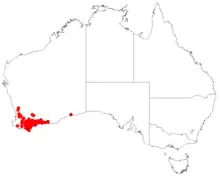| Styphelia concinna | |
|---|---|
| Scientific classification | |
| Kingdom: | Plantae |
| Clade: | Tracheophytes |
| Clade: | Angiosperms |
| Clade: | Eudicots |
| Clade: | Asterids |
| Order: | Ericales |
| Family: | Ericaceae |
| Genus: | Styphelia |
| Species: | S. concinna |
| Binomial name | |
| Styphelia concinna | |
 | |
| Occurrence data from AVH | |
| Synonyms[1] | |
|
Leucopogon concinnus Benth. | |
Styphelia concinna is a species of flowering plant in the heath family Ericaceae and is endemic to the south-west of Western Australia. It is a low-lying shrub with many branches. Its leaves are egg-shaped or oblong, 2–4 mm (0.079–0.157 in) long with a small point on the end and the ends rolled under. The flowers are arranged singly or in pairs in leaf axils on a short peduncle. The sepals, petal tube and petal lobes are about 2 mm (0.079 in) long.[2]
The species was first formally described in 1868 by George Bentham who gave it the name Leucopogon concinnus in Flora Australiensis.[2][3] In 1882, Ferdinand von Mueller transferred the species to Styphelia as S. concinna in his Systematic Census of Australian Plants.[4] The specific epithet (concinna) means "neat" or "pretty".[5]
Styphelia concinna occurs in the Avon Wheatbelt, Esperance Plains, Jarrah Forest and Mallee bioregions of south-western Western Australia and is listed as "not threatened" by the Government of Western Australia Department of Biodiversity, Conservation and Attractions.[6]
References
- 1 2 "Styphelia concinna". Plants of the World Online. Retrieved 4 November 2023.
- 1 2 Bentham, George; von Mueller, Ferdinand (1868). Flora Australiensis. Vol. 4. London: Lovell Reeve & Co. p. 192. Retrieved 11 July 2022.
- ↑ "Leucopogon concinnus". APNI. Retrieved 13 July 2022.
- ↑ "Styphelia concinna". APNI. Retrieved 4 November 2023.
- ↑ Sharr, Francis Aubi; George, Alex (2019). Western Australian Plant Names and Their Meanings (3rd ed.). Kardinya, WA: Four Gables Press. p. 168. ISBN 9780958034180.
- ↑ "Styphelia concinnus". FloraBase. Western Australian Government Department of Biodiversity, Conservation and Attractions.